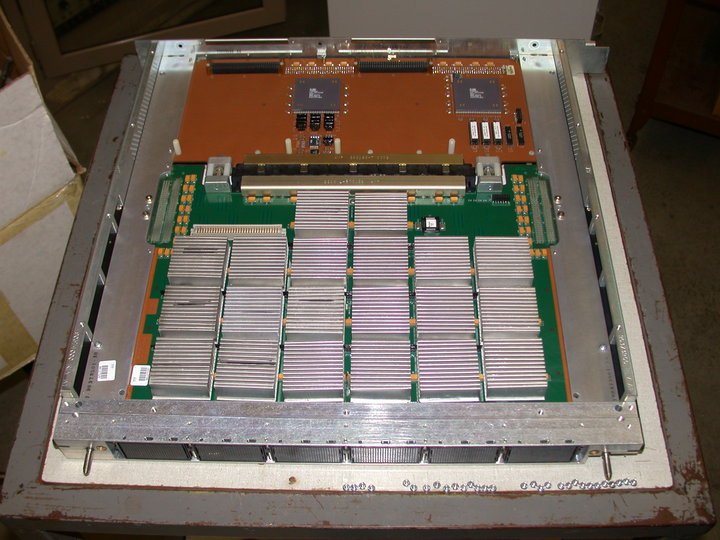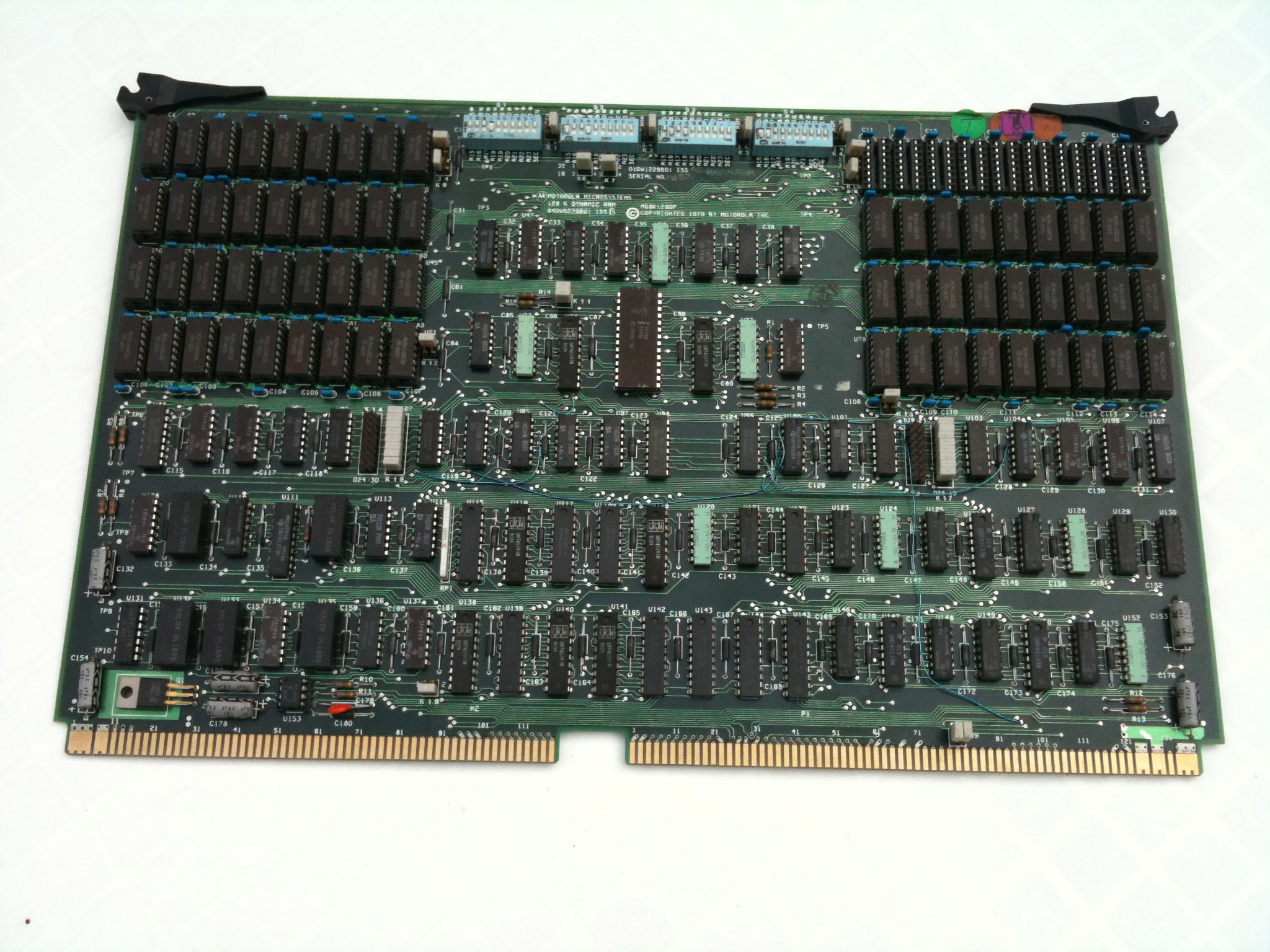|
Cray EL90
The Cray EL90 series was an air-cooled vector processor supercomputer first sold by Cray Research in 1993. The EL90 series evolved from the Cray Y-MP EL minisupercomputer, and is compatible with Y-MP software, running the same UNICOS operating system. The range comprised three models: * EL92, with up to two processors and 64 megawords (512 MB) of DRAM in a deskside chassis: dimensions 42×23.5×26 inches or 1050×600×670 mm (height × width × depth) and 380 lb/172 kg in weight. * EL94, with up to four processors and 64 megawords (512 MB) of DRAM, in the same cabinet as the EL92. * EL98, a revised Y-MP EL with up to eight processors and 256 megawords (2 GB) of DRAM in a Y-MP EL-style cabinet (62×50×32 inches or 2010×1270×810 mm, 1400 lb/635 kg in weight). The EL90 series Input/Output Subsystem (IOS) was based on the VMEbus and a Heurikon HK68 Motorola 68000 The Motorola 68000 (sometimes shortened to Motorola 68k or m68k and usually pro ... [...More Info...] [...Related Items...] OR: [Wikipedia] [Google] [Baidu] |
Vector Processor
In computing, a vector processor or array processor is a central processing unit (CPU) that implements an instruction set where its instructions are designed to operate efficiently and effectively on large one-dimensional arrays of data called ''vectors''. This is in contrast to scalar processors, whose instructions operate on single data items only, and in contrast to some of those same scalar processors having additional single instruction, multiple data (SIMD) or SIMD within a register (SWAR) Arithmetic Units. Vector processors can greatly improve performance on certain workloads, notably numerical simulation, compression and similar tasks. Vector processing techniques also operate in video-game console hardware and in graphics accelerators. Vector machines appeared in the early 1970s and dominated supercomputer design through the 1970s into the 1990s, notably the various Cray platforms. The rapid fall in the price-to-performance ratio of conventional microprocessor de ... [...More Info...] [...Related Items...] OR: [Wikipedia] [Google] [Baidu] |
Supercomputer
A supercomputer is a type of computer with a high level of performance as compared to a general-purpose computer. The performance of a supercomputer is commonly measured in floating-point operations per second (FLOPS) instead of million instructions per second (MIPS). Since 2022, supercomputers have existed which can perform over 1018 FLOPS, so called Exascale computing, exascale supercomputers. For comparison, a desktop computer has performance in the range of hundreds of gigaFLOPS (1011) to tens of teraFLOPS (1013). Since November 2017, all of the TOP500, world's fastest 500 supercomputers run on Linux-based operating systems. Additional research is being conducted in the United States, the European Union, Taiwan, Japan, and China to build faster, more powerful and technologically superior exascale supercomputers. Supercomputers play an important role in the field of computational science, and are used for a wide range of computationally intensive tasks in various fields, ... [...More Info...] [...Related Items...] OR: [Wikipedia] [Google] [Baidu] |
Cray Research
Cray Inc., a subsidiary of Hewlett Packard Enterprise, is an American supercomputer manufacturer headquartered in Seattle, Washington. It also manufactures systems for data storage and analytics. Several Cray supercomputer systems are listed in the TOP500, which ranks the most powerful supercomputers in the world. In 1972, the company was founded by computer designer Seymour Cray as Cray Research, Inc., and it continues to manufacture parts in Chippewa Falls, Wisconsin, where Cray was born and raised. After being acquired by Silicon Graphics in 1996, the modern company was formed after being purchased in 2000 by Tera Computer Company, which adopted the name Cray Inc. In 2019, the company was acquired by Hewlett Packard Enterprise for $1.3 billion. History Background: 1950–1972 In 1950, Seymour Cray began working in the computing field when he joined Engineering Research Associates (ERA) in Saint Paul, Minnesota. There, he helped to create the ERA 1103. ERA eventually became ... [...More Info...] [...Related Items...] OR: [Wikipedia] [Google] [Baidu] |
Cray Y-MP EL
The Cray Y-MP was a supercomputer sold by Cray Research from 1988, and the successor to the company's X-MP. The Y-MP retained software compatibility with the X-MP, but extended the address registers from 24 to 32 bits. High-density VLSI ECL technology was used and a new liquid-cooling system was devised. The Y-MP ran the Cray UNICOS operating system. The Y-MP could be equipped with two, four or eight vector processors, with two functional units each and a clock cycle time of 6 ns (167 MHz). Peak performance was thus 333 megaflops per processor. Main memory comprised 256, 512, or 1024 MB of SRAM. (Memory was measured and allocated in 64 bit words, and offered in 32, 64, or 128 MWords). The original Y-MP (otherwise known as the Y-MP Model D) was housed in a chassis similar to the horseshoe-shaped X-MP, but with an extra rectangular cabinet added in the middle (containing the CPU boards), thus forming a "Y" shape in plan view. The system could be configured with one or two ... [...More Info...] [...Related Items...] OR: [Wikipedia] [Google] [Baidu] |
Minisupercomputer
Minisupercomputers constituted a short-lived class of computers that emerged in the mid-1980s, characterized by the combination of vector processing and small-scale multiprocessing. As scientific computing using vector processors became more popular, the need for lower-cost systems that might be used at the departmental level instead of the corporate level created an opportunity for new computer vendors to enter the market. As a generalization, the price targets for these smaller computers were one-tenth of the larger supercomputers. Several notable technical, economic, and political attributes characterize minisupercomputers. First, they were architecturally more diverse than prior mainframes and minicomputers in hardware and less diverse in software. Second, advances in VLSI made them less expensive (mini-price). These machines were market targeted to be cost-effective and quickly manufactured. Third, it is notable who did not manufacture minisupercomputers: within the USA, IBM ... [...More Info...] [...Related Items...] OR: [Wikipedia] [Google] [Baidu] |
UNICOS
UNICOS is a range of Unix and later Linux operating system (OS) variants developed by Cray for its supercomputers. UNICOS is the successor of the Cray Operating System (COS). It provides network clustering and source code compatibility layers for some other Unixes. UNICOS was originally introduced in 1985 with the Cray-2 system and later ported to other Cray models. The original UNICOS was based on UNIX System V Release 2, and had many Berkeley Software Distribution (BSD) features (e.g., computer networking and file system enhancements) added to it. Development CX-OS was the original name given to what is now UNICOS. This was a prototype system which ran on a Cray X-MP in 1984 before the Cray-2 port. It was used to demonstrate the feasibility of using Unix on a supercomputer system, before Cray-2 hardware was available. The operating system revamp was part of a larger movement inside Cray Research to modernize their corporate software: including rewriting their most important ... [...More Info...] [...Related Items...] OR: [Wikipedia] [Google] [Baidu] |
Operating System
An operating system (OS) is system software that manages computer hardware and software resources, and provides common daemon (computing), services for computer programs. Time-sharing operating systems scheduler (computing), schedule tasks for efficient use of the system and may also include accounting software for cost allocation of Scheduling (computing), processor time, mass storage, peripherals, and other resources. For hardware functions such as input and output and memory allocation, the operating system acts as an intermediary between programs and the computer hardware, although the application code is usually executed directly by the hardware and frequently makes system calls to an OS function or is interrupted by it. Operating systems are found on many devices that contain a computerfrom cellular phones and video game consoles to web servers and supercomputers. , Android (operating system), Android is the most popular operating system with a 46% market share, followed ... [...More Info...] [...Related Items...] OR: [Wikipedia] [Google] [Baidu] |
DRAM
Dram, DRAM, or drams may refer to: Technology and engineering * Dram (unit), a unit of mass and volume, and an informal name for a small amount of liquor, especially whisky or whiskey * Dynamic random-access memory, a type of electronic semiconductor memory * Dram, Welsh term for a minecart, a small railway cargo truck used in a mine railway Currency and geography * Dram, Armenian for "money" ** Armenian dram, a monetary unit ** Artsakh dram (formerly ''Nagorno-Karabakh dram''), a monetary unit * Dram, the Tibetan name for the town of Zhangmu on the Nepal-Tibet border * Historic English name for Drammen, Norway Music * DRAM (musician) (Shelley Marshaun Massenburg-Smith, born 1988), American rapper and actor * Database of Recorded American Music, an online resource * The Drams, an American band made up of members of Slobberbone See also * Dram shop, a bar, tavern or similar commercial establishment where alcoholic beverages are sold * Dirham The dirham, dirhem or drah ... [...More Info...] [...Related Items...] OR: [Wikipedia] [Google] [Baidu] |
VMEbus
VMEbus (Versa Module Eurocard bus) is a computer bus standard physically based on Eurocard sizes. History In 1979, during development of the Motorola 68000 CPU, one of their engineers, Jack Kister, decided to set about creating a standardized bus system for 68000-based systems. The Motorola team brainstormed for days to select the name VERSAbus. VERSAbus cards were large, , and used edge connectors. Only a few products adopted it, including the IBM System 9000 instrument controller and the Automatix robot and machine vision systems. Kister was later joined by John Black, who refined the specifications and created the ''VERSAmodule'' product concept. A young engineer working for Black, Julie Keahey designed the first VERSAmodule card, the VERSAbus Adaptor Module, used to run existing cards on the new VERSAbus. Sven Rau and Max Loesel of Motorola-Europe added a mechanical specification to the system, basing it on the Eurocard standard that was then late in the stand ... [...More Info...] [...Related Items...] OR: [Wikipedia] [Google] [Baidu] |
Motorola 68000
The Motorola 68000 (sometimes shortened to Motorola 68k or m68k and usually pronounced "sixty-eight-thousand") is a 16/32-bit complex instruction set computer (CISC) microprocessor, introduced in 1979 by Motorola Semiconductor Products Sector. The design implements a 32-bit instruction set, with 32-bit registers and a 16-bit internal data bus. The address bus is 24 bits and does not use memory segmentation, which made it easier to program for. Internally, it uses a 16-bit data arithmetic logic unit (ALU) and two more 16-bit ALUs used mostly for addresses, and has a 16-bit external data bus. For this reason, Motorola termed it a 16/32-bit processor. As one of the first widely available processors with a 32-bit instruction set, large unsegmented address space, and relatively high speed for the era, the 68k was a popular design through the 1980s. It was widely used in a new generation of personal computers with graphical user interfaces, including the Macintosh 128K, Amiga, ... [...More Info...] [...Related Items...] OR: [Wikipedia] [Google] [Baidu] |







